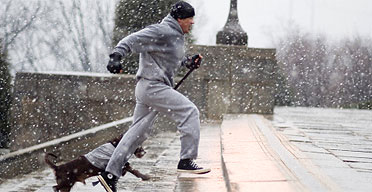
Mehdi Jabrane had dreamed of making the pilgrimage. Born to a Moroccan Muslim father with a drink problem and a French Catholic mother, 25-year-old Jabrane grew up in France in a housing project for immigrant workers. His parents divorced when he was 16. "Because I never used to talk with my father," he says, "I always tried unconsciously to find a paternal figure."
And then one night this lost soul saw the film Rocky. "I was shocked," he says, "because a guy from nowhere made an incredible thing, becoming the world champion, a thing he never dreamed because it was so far from his reality." Jabrane became obsessed with the film and one scene in particular: the boxing hero running up the 72 steps of the Philadelphia Museum of Art. Jabrane knew he had to run the steps himself. In 1998, after four months mopping floors, he had the money to fly to the US and emulate his idol. Freshly inspired, he returned home and began to turn his life around. The high school dropout got a degree and a job with a pharmaceutical firm. These days, whenever the motivation slips he returns to Philadelphia to run the Rocky steps. "I feel great, untouchable, proud," he says.
Jabrane is not the only Rocky disciple to make the pilgrimage. Fans have been re-enacting the famous scene ever since the release of the original, Oscar-winning Rocky film back in 1976. Michael Vitez, a reporter for the Philadelphia Inquirer, has seen them almost every day of the 22 years he has been in the city. "Everybody who lives here sees people do this," he says. "It always struck me how happy they are when they reach the top. I knew in my gut that I would find great stories there."
Vitez was so intrigued by who these people were and what compelled them to make the journey to Philadelphia that he and photographer Tom Gralish spent a year outside the Museum of Art listening to their stories. "We were purists," Vitez says. "We didn't want to interfere with their experience. I called it following the Star Trek Non-Interference Directive. I didn't want to interfere with the Rocky moment until it was over. We'd just hang and wait and then we'd approach them."
Fifty-two of Vitez's interviews have now been brought together in a new book, Rocky Stories. As well as Jabrane, we meet a recovering drug addict who sweeps snow from the steps, a heart-transplant survivor, a Turkish woman who defied the odds to attend business school, a schoolteacher who proposed to his girlfriend on the steps . . . The characters in Rocky Stories have, like Rocky, overcome long odds and remained standing; they have known death, disease and despair but they have not yet been beaten. They come to Philadelphia and run the steps not in desperation but in celebration. "When they run they are celebrating their own lives," says Vitez, "their own dreams, friendships, and accomplishments. It's true that some people run as a kitschy, corny, tourist-like thing to do, but many of these people are still surprised at how emotional they feel at the top of the steps."
When Stallone learned about the book, he offered to contribute a foreword. Writing in the book, he suggests that the reason people still run the steps is that "when you train for Rocky, you basically train for yourself. Because we are underdogs. And there's very few things, iconic situations, that are accessible. You know, you can't borrow Superman's cape. You can't use the Jedi laser sword. But the steps are there. The steps are accessible. And standing up there, you kind of have a piece of the Rocky pie. You are part of what the whole myth is."
During the end sequence of the new Rocky film, Rocky Balboa, Stallone acknowledges the power of that myth. As the credits roll we see footage of ordinary men, women and children running up the steps - among them Vitez and Gralish.
With Stallone now 60 and Rocky Balboa widely panned, it is fair to say that few expected the latest Rocky film to be anything other than an embarrassment. And yet, against the odds, Rocky Balboa has been both a critical and commercial success in the US, precisely because it taps into what made the first Rocky film so powerful 30 years earlier: when Rocky ran the steps all those years ago his goal was not to win but to go the distance, to prove to himself that he was somebody and not "just another bum from the neighbourhood". It is that sentiment that is revealed in the best tales in Rocky Stories - that it ain't over till it's over and in the end the only fight that matters is with yourself.
· Rocky Stories: Tales of Love, Hope and Happiness at America's Most Famous Steps, by Michael Vitez and Tom Gralish, is published by Paul Dry Books, price £11.90.
· Rocky Balboa is on general release.

